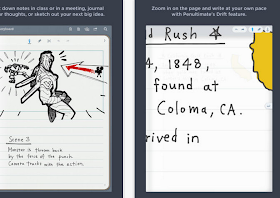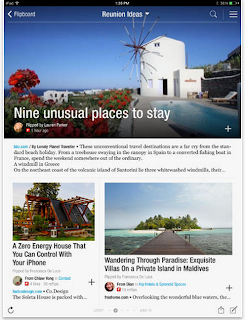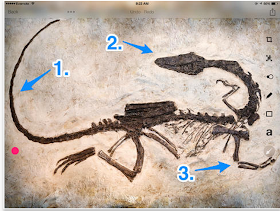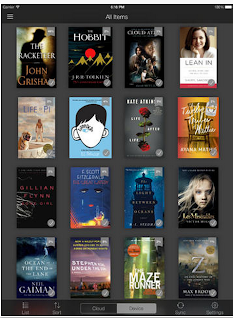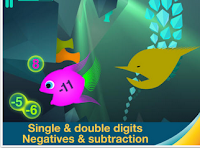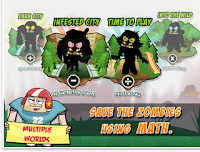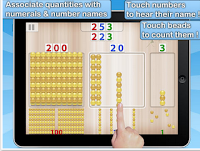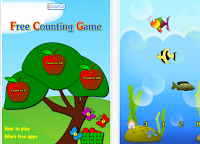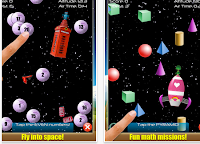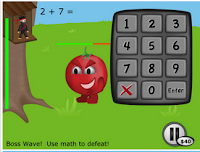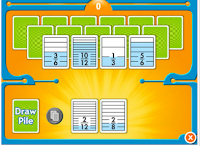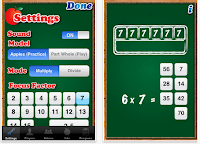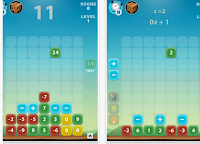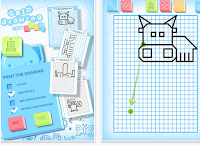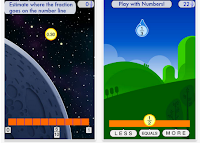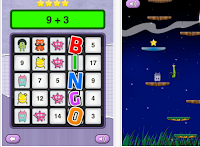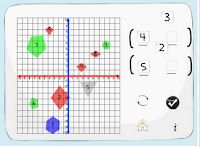24 Good iPad Math Apps for Elementary Students
http://www.educatorstechnology.com/2013/12/24-good-ipad-math-apps-for-elementary.html
1- Motion Math
Feed your fish and play with numbers! Practice mental addition and subtraction with Motion Math: Hungry Fish, a delightful learning game that’s fun for children and grownups.
2- Geoboard
The Geoboard is a tool for exploring a variety of mathematical topics introduced in the elementary and middle grades. Learners stretch bands around pegs to form line segments and polygons and make discoveries about perimeter, area, angles, congruence, fractions, and more.
3- Math Vs Zombies
The world is overrun with zombies. You are a part of a squad of highly trained scientists who can save us. Using your math skills and special powers you can treat infected zombies to contain the threat.
4- Mystery Math Town
It’s part math drills, part seek and find game and totally engaging. Kids ages five and up should find this both fun and challenging. Parents should rejoice that finally there is a way to get kids to want to do more math. – Smart Apps for Kids
5- Montessori Numbers
Montessori Numbers offers a sequence of guided activities that gradually help children reinforce their skills. Each activity offers several levels of increasing complexity
6- Free Kids Counting Game
FREE and fun picture math games for kids designed by the iKidsPad team. This free iPad math app dynamically generates thousand of beginning counting games with different themes and number levels. Great interactive and challenging games helps young children build up basic counting skills and number recognition.
7- Math Puppy
Math Puppy will take you on a journey of educational fun like never before!
From toddlers to grade school, for Children of all ages – Math Puppy is the perfect way to build up your math skills. Your child will be able to enjoy a constructive, supportive, interactive fun filled environment while mastering the arts of basic math.
8- Mathmateer
While your rocket is floating weightlessly in space, the real fun begins! Play one of the many fun math missions. Each mission has touchable objects floating in space, including stars, coins, 3D shapes and more! Earn a bronze, silver or gold medal and also try to beat your high score. Missions range in difficulty from even/odd numbers all the way to square roots, so kids and their parents will enjoy hours of fun while learning math.
9- Math Ninja
Use your math skills to defend your treehouse against a hungry tomato and his robotic army in this fun action packed game! Choose between ninja stars, smoke bombs, or ninja magic – and choose your upgrades wisely!
10- Everyday Mathematics
The Equivalent Fractions game by McGraw Hill offers a quick and easy way to practice and reinforce fraction concepts and relationships. This game runs on the iPad, iPhone, and iPod Touch.
11- Elementary School Math
Based on the classroom hit Middle School Math HD, Elementary School Math HD is a stunningly beautiful and powerfully engaging application built for today’s technology-driven elementary school classroom. Emphasizing game-playing and skill development, the eight modules in Elementary School Math HD have been carefully designed by classroom teachers to provide the perfect balance between fun and the practice of fundamental skills
12- Math Tappers
MathTappers: Multiples is a simple game designed first to help learners to make sense of multiplication and division with whole numbers, and then to support them in developing fluency while maintaining
accuracy.
13- Ordered Fractions
Two Player Bluetooth Math Game! You can use two devices and play competitively or cooperatively with your classmates or parents. Ordered Fractions provides a comprehensive tool that offers an innovative method of learning about comparing and ordering fractions.
14- SlateMath
SlateMath is an iPad app that develops mathematical intuition and skills through playful interaction. The app’s 38 activities prepare children for kindergarten and first grade math. SlateMath forms the foundation of numbers, digit writing, counting, addition, order relation, patterns, parity and problem solving.
15- NumberStax
Number Stax is a puzzle game to test your number skills! Drop numbers and operators in the correct places to match the number or expression shown at the top of the screen to score. You can’t remove tiles but you can swap them around. You can freeze the game at any time, but remember to watch the clock! Eliminate tiles, score points, and earn bonuses and achievements for as long as possible until your grid is full! Remember, the longer you play the faster it gets. Share with your family and friends to see who can get the highest score.
16- Grid Drawing
With a sheet of paper, a grid and a template, your children will be able to draw 32 drawings on iPad, 16 on the iPhone in the Lite version, more than 120 (60 on iPhone) in the full version.
17- Motion Math
Developed at the Stanford School of Education, Motion Math HD follows a star that has fallen from space, and must bound back up, up, up to its home in the stars. Moving fractions to their correct place on the number line is the only way to return. By playing Motion Math, learners improve their ability to perceive and estimate fractions in multiple forms.
18- 5th Grade Math
Splash Math is a fun and innovative way to practice math. With 9 chapters covering an endless supply of problems, it is by far the most comprehensive math workbook in the app store.
19- Sushi Monster
Meet Sushi Monster! Scholastic’s new game to practice, reinforce, and extend math fact fluency is completely engaging and appropriately challenging.
20- Math Monsters
Math Monsters Bingo is a new, fun way to master math on your iPhone, iPad and iPod touch. The game lets you practice math anytime and anywhere using a fun Bingo styled game play.
21- Grid Lines
Grid Lines is a Battleship-style math game used to teach students the coordinate plane by plotting points in all four quadrants.
22- Marble Math
http://podnetwork.org/event/pod-2013/
Conference program available in PDF and upub format, so I can have it on my laptop and on my mobile device: diminishes the necessity to carry and pull constantly a paper stack.
it is the only conference I know with 6AM yoga. Strong spirit in a strong body. LRS & CETL must find space and instructors an offer mediation + yoga opportunity for SCSU students to disconnect
1:00 – 5:00 PM excursion to Carnegie Mellon – Learning Spaces. LRS interest in Learning Commons.
From the pre-conference workshops, Thurs, Nov 7, 8:30AM – 12:00PM:
Linda Shadiow, Connecting Reflection and Growth: Engaging Faculty Stories.
This workshop seems attractive to me, since it coincides with my firm conviction that SCSU faculty must share “best practices” as part of the effort to engage them into learning new technologies.
Kenyon, Kimberly et al, Risky Business: Strategic Planning and Your Center.
This workshop might be attractive for Lalita and Mark Vargas, since strategic planning is considered right now at LRS and CETL might also benefit from such ideas.
roundtables, Thurs, Nov. 7, 1:30-2:45PM
Measuring the Promise in Learner-Centered Syllabi
Michael Palmer, Laura Alexander, Dorothe Bach, and Adriana Streifer, University of Virginia
Effective Faculty Practices: Student-Centered Pedagogy and Learning Outcomes
Laura Palucki Blake, UCLA
Laura is the assistant director http://gseis.ucla.edu/people/paluckiblake
3 time survey of freshmen. survey also faculty every 3 years. can link this date: faculty practices and student learning
triangulating research findings. student-centered pedagogy. which teaching practices are effective in promoting student-center learning practices.
no statistical differences in terms of student learning outcomes between part-time and full-time faculty. The literature says otherwise, but Laura did not find any statistical difference.
http://ow.ly/i/3EL77
discussions is big, small group work is big with faculty
in terms of discussions, there is huge difference between doing discussion and doing it well.
this is a self-report data, so it can be biased
there are gender differences. women more likely to use class discussions, cooperative learning same, students presentations same. gender discipline holds the gender differences. same also in STEM fields.
students evaluations of each other work. cooperative learning: it is closer gender-wise.
the more student-centered pedagogy, the less disengagement from school work.
understand on a national level what students are exposed to.
lpblake@hmc.edu
http://www.heri.ucla.edu/
wabash national data.
ePublishing: Emerging Scholarship and the Changing Role of CTLs
Laura Cruz, Andrew Adams, and Robert Crow, Western Carolina University
LORs are in Kentucky.
CETL does at least Professional Development, Resources, Eportfolios, LORSs. FLCs
Teaching Times at Penn.
model 2: around instructional technology. More and more CETL into a combined comprehensive center. about 9 are paid by IT and 11 by academic center. because of finances cuts this is the model predicted from the 90s. Why not IT? because ater they say how to use it. and how to use it effective. think outside of technology, technogogy is not the same as technology. Teacher-scholar model: research, service, teaching.
http://ow.ly/i/3EMJl
egallery and other electronic ways to recognize productivity. Stats and survey software does NOT reside with grad studies, but with CETL, so CETL can help faculty from a glimmer of an idea to presentation and publication. Research Support Specialist.
how and where it fits into faculty development. Neutrality. Should CETL be advocates for institutional, organizational change. Do CETL encourage faculty to take innovation and risk (change the culture of higher ed). Tenure and promotion: do we advocate that epub should count, e.g. a blog will count toward tenure.
a national publication: http://www.sparc.arl.org/resources/authors/addendum
we domenstrate that it is good school. scholarship of teaching will be good teaching.
OER? Open educational resources. SHould CETL host and participate in those? Do we participate in creating resources, which are designed to replace texbooks? Caroline has a state-wide grant to support faculty developing learning resources.
open access is controversial. the right to publish and republish. http://www.sparc.arl.org/
40% of all scholarly articles are owned by 3 publishers
Academic Social Media academic.edu and electronic journals.
CETL is the comprehensive center, the hub where people go to, so CETL can direct them to and or get together stakeholder to make things happen.
the lesson from this session for me is that Lalita and Keith Ewing must work much closer.
Evaluating the quality of MOOCs: Is there room for improvement?
Erping Zhu, University of Michigan; Danilo Baylen, University of West Georgia
reflection on “taking” a MOOC and the seven principles. how to design and teach MOOC using the seven principles.
MOOC has a lot of issues; this is not the focus, focus is on the instructional design. Both presenters are instructional designers. Danilo is taking MOOC in library and information science.
Second principle: what is a good graduate education.
about half had completed a course. Atter the 3rd week the motivation is dissipating.
Erping’s experience: Provost makes quick decision. The CETL was charged with MOOC at U of Michigan. Securing Digital Democracy. http://www.mooc-list.com/university-entity/university-michigan
Danilo is a librarian. his MOOC class had a blog, gets a certificate at the end. Different from online class is the badges system to get you involved in the courses. the MOOC instructors also had involved grad students to monitor the others. the production team is not usually as transparent as at Corsera. Sustainability. 10 week module, need to do reflections, feedback from peers. 7 assignments are too much for a full-time professional.
http://www.amazon.com/Library-2-0-Guide-Participatory-Service/dp/1573872970
http://tametheweb.com/category/hyperlibmooc/
http://tametheweb.com/2013/10/20/hyperlibmooc-library-2-013-presentation-links/
1. principle: contact btw faculty and student. Not in a MOOC. video is the only source provides sense of connection. the casual comments the instructor makes addressing the students provides this sense. Quick response. Collaboration and cooperation in MOOC environment and bring it in a F2F and campus teaching. Feedback for quizzes was not helpful to improve, since it i automated. students at the discussion board were the one who helped. from an instructional design point of view, how MOOC design can be improved.
group exercise, we were split in groups and rotated sheet among each other to log in response to 7 sheets of paper. then each group had to choose the best of the logged responses. the responses will be on the POD site.
eri week resources
Per Keith’s request
“Why Students Avoid Risking Engagement with Innovative Instructional Methods
Donna Ellis, University of Waterloo”
Excerpt From: Professional and Organizational Development Network in Higher Education. “POD Network 2013 Conference Program, Pittsburgh PA 11/7 to 11/10.” iBooks.
This material may be protected by copyright.
A quantitative study. The difficulty of group works. Various questions from the audience, the time of class (early Mrng) is it a reason to increase the students disengagement. Students pereceptions .
The teacher did. It explain why the research and this might have increased the negative perception. Summary of key barrierS.
Risk of negative consequneces
preceived lack of control
contravention of perceived norms.
fishbein and Aizen 2010
discussoon . How faculty can design and deliver the course to minimize the barriers. Our table thought that there are a lot of unknown parameters to decide and it is good to hear the instructor nit only the researcher. How to deal with dysfunctional group members behaviors. Reflections from the faculty member how to response to the data? Some of the barriers frustrated him. Outlines for the assignments only part of the things he had done to mitigate. What are we asking students on course evaluations. Since a lot more then only negative feedback. Instructor needes more training in conflict resolution and how to run group work.
http://ow.ly/i/3Fjqt
http://ow.ly/i/3Fjpq
CRLT Players
Friday, Nov 8, 10:30 AM – 12:00 PM
William Penn Ballroom
7 into 15
CRLT Players, University of Michigan”
Excerpt From: Professional and Organizational Development Network in Higher Education. “POD Network 2013 Conference Program, Pittsburgh PA 11/7 to 11/10.” iBooks.
This material may be protected by copyright.
It is a burlesque and theater approach to engage students and faculty into a conversation. 10 plays in 30 min.
Discuses different topics from the plays and seek solutions as a team. How to deal with international students ( Harvard lady said ” safe places” for students) how to deal with technology or the lack of it, missed next one writing this notes and how to reward faculty in innvative things. T. Encoruage innovation, they received a letter from the provost and if they fail, it is not used in their annual evaluation
No videotaping of this performance because the power is in conversation. Is there a franchise, like training people to do that. NSF grant was allowing them but now just pick up the idea. Sell scripts? Can have conversations about strategies how to collaborate with the theater department where to start these short vinniets. If come to campus and bring performance do they do also the follow up.
Is anger or hostility a reaction during after these presentations. How to handle it. Hostility can be productive and make sure that it is told that it is productive. Getting difficult things out there is what the theater is trying to do in a distant way. This is not a morality
how develop the work? How come up with issues. Faculty bring issues, followed by interviews, draft created we heater identifies the problem and address the issue. Preview performances with stakeholders who confirm . There are more then. Sufficient ideas, so the organizers can choose what they see most pertinent
ecrc committee went to their meeting instead of lunch to see if I can particpirate for next year activitities. Ecrc is the acronym for the tech committee. Web site is one takes of this committee. Word press site , how the groups work, how forms work, how to connect with people and most importantly how to start communicating through the web site and cut the listserv. An attempt to centralized all info in the website rather then scattered across universities.
what is BRL? Google apps and Wikipedia as a wiki for another year until figure out if it can be incorporated in the web site. Reconceptualize how do work in the process. To groups in ecrc. Wikpaidea and web page. And then social media with Amy? Ecrc liaison in every POD committee to understand how to set up the committee web presence. Blackboard collaborate to do meetings and this is what liason explain to committee members. Tinyurl.com/ECRC2013
Designing Online Discussions For Student Engagement And Deep Learning
Friday, Nov 8, 2:15 PM – 3:30 PM, Roundtable
Parkview East
Danilo M Baylen, University of West Georgia”
pit must be asynchronous discussion
What is the purpose and format of the discussion. Assessment. How the online discussion is supporting the purpose of the curriculum to the students learning
About five discussions per semester all together. Behaved part of the class culture
Format of the assignment
asynchronous discussion list. Series of questions or a case study. Is the format a sequence of responses or invite a discussions
checklist which stifles a creative discussion or just let it more free
purpose – must be part of the syllabus and it must be clear.
Meeting learning objectives.
duration
interactivity – response to other students. List of 6 different options how they can reply. what format the interactivity takes Is important issue, which has no textbook
assessment- initial posting are critical, since it gives and idea what to work on. How much points as part of the bigger picture. Yet it is the ground work for the assignment, which gets most points.
metacognitive not evaluative , give students examples from the pro regions class what a good discussion is And explain students how to. Evaluate a good discussion entry
how the question is worded and use the threaded discussion for them to reflect how they think, rather then only assess if they read the chapter. The research about online discussion is very different.
What is the baseline.
Online course must must be set up ready before semester starts or not?
reflection for the end of the semester
SteVn brookfields critical questionaire
meet thISTI and qr standards
is reflection on the content or the process
students reflect on their own reflections
what have you learned about yourself as online learner and look for consistencies for both negative and positive reflections
Assess critical thinking
there is a workshop by the presenters instituitions how to organize
more claims then actual evidence so Data is sought to
main issues
programmatic emportfolio. Not student presentation portfolios, but academic portfolio
e portfolio forum
look at image of the green copy:
1. Integration and reflection
2. Social media – in community with other students , faculty, organizations
3. Resume builder
eportfolio is. Prt of the assessment. Conversation on campus. Some depts use exportfolio extensively but not happy. Programmatic academic e portfolio to collect data
use Sakai open portfolio system
12 drepartments and six more second year. to speak the same language, they developed a guideline, conceptual framework ( see snapshot of handout)
Curriculum mapping ( see the grid on the. Handout) took much longer then expected.
the role of CETL. The provost at Kevin’s institution charged CETL to do the portfolio gig.
The big argument of the CETL redirector with the provost is that portfolio not only to collect data for assessment and accreditation but to provide meaningful experience for the students. EDUCAUSE report horizon, learning analytics Scandalous headlines of students suing law schools. bad deductions made on big data. The things that matte for students must be in the portfolio and they get used to use the portfolio. Pre reflection entries by the students, which shorted the advising sessions. The advisor can see ahead of time. The advisers. Will. B the. Focus point, The. Advising portfolio Is becoming
portfolio must be used by faculty not only students.
Whats the by in for students. Presentations portfolio part of. Marketing purposes. Google sites so when students leave the institutions students can ” take” the portfolio with them as we’ll go multimedia. attempts failed because platforms which can be cutozmized we’re not used Digital identity As CETL director not technology expect and how to learn from the faculty and that was very
documenting and learning with eportfolios.
faculty to demonstrate reflections to students and how enter into portfolio. Using rubrics. Faculty are using already tools but connecting with. Reflections.
STAR: Situation , tasks, action, response
Writing skills differentiate, but even good writers got better on reflection
how one polish a portfolio before bringing to an Employer. Student Working with career services to polish and proofread.
How much the university is responsible for an individual portfolio. How many levels of proof reading.
Poor student work reflects a poor faculty attention.
Lorna Kearns, University of Pittsburgh”
Freedom to Breathe: A Discussion about Prioritizing Your Center’s Work
Andy Goodman and Susan Shadle, Boise State University
Connecting, Risking, and Learning: A Panel Conversation about Social Media
Michelle Rodems, University of Louisville. Conference C 9:00 AM – 10:15 AM
The use of social media in higher education
Conference C 9-11:15 AM
Panel of CETL directors and faculty. The guy from Notre dame uses word press the same way I use it. Collect questions and after the 3rd one creates blog entry and answers the next q/ s with the URL to the blog entry NspireD is the name of. The blog
the OHIO state UCAT guy is a twitter guy. Program coordinator who manages wordpress and web site. Intersect with FB and twitter. Platforms are inteGrated, so be did not to know the technicalities. The graduate consultants are setting up. ciirdinator tried to understand how the mesh together. Can be used as conversation starters or to broadcast and share info. Use of hashtags how to use them appropriate in twitter and FB to streamline .
Scsu problem. W don’t build it they will not come. a Tim burton version of the field of dreams.
Rachel CETL assist dir at U of Michigan. She is out there personally likes it. Very static web page. Drupal as a content management system so the blog is part of the web page. So 2 times a week entries. One of the staff people is an editor and writes blog posts, but vetted by a second CETL staff. Auto push for the blog to the twitter. Screencasts for YouTube channel with screencasts. Comments on the blog minimal from faculty and stat. What about students? About 1000 followers on the twitter. What do analytics say. Hits on home page, but no idea how much time reading. The time people spend more time and using the tags . the use of blog is less formal way to share information. recycling in December and August a lot of material.
does anybody subscribe and do you promote RSS
the separate blog for a workshop requires interaction and that is a success
for faculty development U of Michigan is using blog recruited 50 to follow the blog. TSam of 3 using. WordPress For a semester and then survey. Focus group. Huge success, between 6 and 30 comments. Community with no other space on campus
how are u using social media to promote connections. elevate voices of others on campus by interviewing faculty. At U of Michigan there was no interest to learn about what other faculty are doing. So they trashed that initiative but starTed a video narration about faculty who innovate. Videotaped and edited no hi Qual video , tagged and blog posted and this approach created more connection, because it is not text only.
What have been the obstacles and indoor failure and what have you learned?
convincing the administration that CETL than do it and it does not have to be the same quality as the web page and the printed material. Changing the mindset. No assessment, since nothing else was working and they were ready for radical step such as blog
Same with the twitter. Taking the risk to experiment with the hashtags. Tweets can’t be approved. Need to time to build an audience, one month will not have an impact. Start with the. Notion that you are building a reposIvory noT a foRum
one of the panelist has a google spreadsheet which has information of allCETL social media sites There are resources on how to deal with negative outcomes of using social media. Working with librarians, the Norte dame said! they will give you twenty sources. No no, no, he siad, give me your best three.
U of MichiGan more grad studns blog guest posts almost no faculty.
Have you considered giving them more then guest blog, but no facilitator? Let faculty once a semester do a blog post. It is not moderated but more like lead to how to do a good blog. Interview based approach is unique and does not show up somewhere elSe.
Insitutional background important in these decisions.
How often refresh the wordpress page. How often one person is voicing and it takes a log of journalistic skills. Use the draft option to publish when there are several ideas coming at once.
Mindshift of CETL is to decrease the standards. Make it more informal. Blog post can be always fixed later. To avoid faculty false perception that this is not scholarly needs to be references. So causal tone + references.
Blog ” from students perspective” is repurposE
Risking Together: Cultivating Connection and Learning for Faculty Teaching Online
Michaella Thornton, Christopher Grabau, and Jerod Quinn, Saint Louis University
Oliver 9-11:15 AM
Space Matters! and Is There a Simple Formula to Understand and Improve Student Motivation
Kathleen Kane and Leslie A. Lopez, University of Hawaii at Manoa
Riverboat 9:00 AM – 10:15 AM
The Risks and Rewards of Becoming a Campus Change Agent
Dr. Adrianna Kezar, University of Southern California
William Penn Ballroom 10:30 AM – 12:00 PM
Branch campuses, students abroad, to more with less, completion from profit institutions
students work more but this is a good reflection on learning success
provost might ask to consolidate prof development opportunities for faculty and students instead of faculty only.
If administration is genuine understand transparent Administration more about persuading not listening. Respect, not assuming that faculty will not accept it. If faculty will sacrifices what will faculty see the administration sacrifice on their side. Leading from the. Middle , it means collective vision for the future. Multilevel leadershup, top down efforts dont work and bottom top are fragile. Managing up is less preferred then powering up. It is difficult to tell administration that they miss or misunderstand the technology issue.
Four frames. Goal multi frame leadership http://www.tnellen.com/ted/tc/bolman.html. Vey much the same as Jim Collins good to great right people on the bus right trained http://www.afa1976.org/Portals/0/documents/Essentials/Creating%20Organizational%20Learning%20and%20Change.pdf
How to build coalition, different perspectives, aknowledge the inherent conflict.
The Delphi project
It Takes a Campus: Promoting Information Literacy through Collaboration
Karla Fribley and Karen St. Clair, Emerson College
Oakmont 1:45 PM – 3:00 PM
Most of the attendees and both presenters were librarians
The presenters played a scatch to involve the particppaints
deifnition what is IL. https://mobile.twitter.com/search/?q=%23POD13&s=hash
http://ow.ly/i/3G00e/original
Information literacy collaborative work with faculty to design student learning outocmes for information literacy
Guiding principles by backward course design
Where they see students struggle with research
question to students survey, what is most difficult for your and wordle.
http://ow.ly/i/3G0l6/original
self reflection ow.ly/i/3G0UH
Curriculum mapping to identify which courses are the stretigic ones to instill the non credit info litreacy
acrl assessment in action
Risky Business: Supporting Institutional Data Gathering in Faculty Development Centers
Meghan Burke and Tom Pusateri, Kennesaw State University
Oliver 1:45 PM – 3:00 PM Roundtable
Exploring Issues of Perceptual Bias and International Faculty
Shivanthi Anandan, Drexel University.
Heinz 3:15 PM – 4:30 PM Roundtable
Why do we need it and onoy regarding international faculty don’t in Kim Lisa wolf-wendel
susan twombly. Pointers for hiring and retention. Performance is both teaching and living. Sanitary effect. sanitary issues not only pay rate. FLC all tenure track without citizenship they are worried about their tenure. Funding agencies, very few will fund you if you are not a citizenship
Diane Schafer perceptual biases, graffiti. Cathryn Ross
Averting Death by PowerPoint! From Killer Professors to Killer Presenters
Christy Price, Dalton State College
Riverboat 4:45 PM – 6:00 PM
How to create effective mini lectures checklist for acting palnning
engage and leave lecture out. The reason why can’t move away is because some people lecture as performance art
Make lectures mini. How long mini should be. 22 min, the age number of the person.
Emotional appeal, empathy.
Evoke positive emotions with humor. Always mixed method research, since the narrative Berk, r. (2000) and Sousa (2011)
ethical. Obligations and emotional appeal
acknowledge the opposition
enhance memory processing with visuals and multimedia
use guided practice by miniki zing note taking
presentationzen is a book! which need to read http://www.barnesandnoble.com/w/presentation-zen-garr-reynolds/1100391495?ean=9780321525659
Enchanted memory processing by creating mistery
address relevance
http://advanceyourslides.com/2011/01/28/the-5-most-memorable-concepts-from-nancy-duartes-new-book-resonate/
Death by PowerPoint: Nancy Duarte: The secret structure of great talks
http://www.ted.com/talks/nancy_duarte_the_secret_structure_of_great_talks.html
http://www.gobookee.org/get_book.php?u=aHR0cDovL3d3dy5vcGVuaXNibi5jb20vZG93bmxvYWQvMDQ3MDYzMjAxMS5wZGYKVGl0bGU6IFJlc29uYXRlOiBQcmVzZW50IFZpc3VhbCBTdG9yaWVzIFRoYXQgVHJhbnNmb3JtIC4uLg==
Engage faculty by showing. Faculty how their presentation. Is. And how it c can be
process with clickers
Sunday Mrng session
vygotsky zone of NAND the flipped mindset. http://t.co/vCI8TOJ7J2. Cool tweets at #pod13.
Ideas process baudler Boyd stromle 2013
I – identify the issue
D debrief the situation
A analyze what happened
s strategize solutions and Oport unities for growth and future success
A a workshop for COLL 150 and HONS 100 instructors on May 10.
Here is the outline and resources.
Media Literacy and Skills
Media Literacy (according to Wikipedia — http://en.wikipedia.org/wiki/Media_literacy)
The term has been conceived in many different ways and across all academic departments (Mihalidis, 2008).
Media literacy is central in a broader concept of access (Sourbati, 2009).
The relationship between visual competencies and the notion of media literacy have not been fully explored or adequately specified (Griffin, 2008).
Media literacy interventions refer to education programs designed to reduce harmful effects of the media by informing the audience about one or more aspects of the media, thereby influencing media-related beliefs and attitudes, and ultimately preventing risky behaviors. Positive effects of media literacy interventions were observed across diverse agents, target age groups, settings, topics, and countries (Jeong et al, 2012).
Media literacy, information literacy and digital literacy are the three most prevailing concepts that focus on a critical approach towards media messages
The 21st century has marked an unprecedented advancement of new media. New media has become so pervasive that it has penetrated into every aspect of our society. New media literacy plays an essential role for any citizen to participate fully in the 21st century society. Researchers have documented that literacy has evolved historically from classic literacy (reading-writing-understanding) to audiovisual literacy to digital literacy or information literacy and recently to new media literacy. A review of literature on media literacy reveals that there is a lack of thorough analysis of unique characteristics of newmedia and its impacts upon the notion of new media literacy. The purpose of the study is to unpack new media literacyand propose a framework for a systematic investigation of new media literacy
Hobbs versus Potter
Media Skills
Ten basic new media skills that today’s journalist should know: http://www.siliconvalleywatcher.com/mt/archives/2008/03/ten_basic_new_m.php
- HTML is not dead. QR codes are only one new technology, which can revive it. But:
- WordPress might be preferable to Adobe Dreamweaver.
- PPT is not enough. Prezi does not replace it. Then what? Desktop/lpatop versus tablet (Stampsy). Or the Cloud m(VoiceThread)? Does Media skills = presentation skills?
- iMovie | Movie Maker (local) versus YouTube (Cloud)
- Flickr (Cloud) versus Photoshop (local).
Sources:
Mihailidis, P. (2008). Are We Speaking the Same Language? Assessing the State of Media Literacy in U.S. Higher Education. Simile, 8(4), 1-14. doi:10.3138/sim.8.4.001 http://search.ebscohost.com/login.aspx?direct=true&db=aph&AN=40303609
Hobbs, R. (2011). EMPOWERING LEARNERS WITH DIGITAL AND MEDIA LITERACY. Knowledge Quest, 39(5), 12-17. http://search.ebscohost.com/login.aspx?direct=true&db=aph&AN=61819923
http://www.knightcomm.org/digital-and-media-literacy-a-plan-of-action/
Koltay, T. (2011). The media and the literacies: media literacy, information literacy, digital literacy. Media, Culture & Society, 33(2), 211-221. doi:10.1177/0163443710393382 http://search.ebscohost.com/login.aspx?direct=true&db=aph&AN=59569702
“Victor” CHEN, D., WU, J., & WANG, Y. (2011). Unpacking New Media Literacy. Journal Of Systemics, Cybernetics & Informatics, 9(2), 84-88. http://search.ebscohost.com/login.aspx?direct=true&db=aph&AN=83259046
Sourbati, M. (2009). Media Literacy and Universal Access in Europe. Information Society, 25(4), 248-254. doi:10.1080/01972240903028680 http://search.ebscohost.com/login.aspx?direct=true&db=aph&AN=43050924
GRIFFIN, M. (2008). Visual competence and media literacy: can one exist without the other?. Visual Studies,23(2), 113-129. doi:10.1080/14725860802276255 http://search.ebscohost.com/login.aspx?direct=true&db=aph&AN=33944793
Jeong, S., Cho, H., & Hwang, Y. (2012). Media Literacy Interventions: A Meta-Analytic Review. Journal Of Communication, 62(3), 454-472. doi:10.1111/j.1460-2466.2012.01643.x http://search.ebscohost.com/login.aspx?direct=true&db=aph&AN=76349359
Yates, B. L. (2002). Media education’s present and future: A survey of teachers. Simile, 2(3), N.PAG. http://search.ebscohost.com/login.aspx?direct=true&db=aph&AN=10537377
Technology Literacy and Skills
Technology Literacy
definition:
consider this: http://blog.lib.umn.edu/chri1010/TLI/023958.html
Technology Literacy is the ability to responsibly use appropriate technology to communicate, solve problems, and access, manage, integrate, evaluate, and create information to improve learning in all subject areas and to acquire lifelong knowledge and skills in the 21st century.
Technology literacy is the ability of an individual, working independently and with others, to responsibly, appropriately and effectively use technology tools to access, manage, integrate, evaluate, create and communicate information.
http://www.montgomeryschoolsmd.org/departments/techlit/docs/Definition%20of%20Technology%20Literacy.pdf
“Technological Literacy is the ability to use, manage, assess, and understand technology” (Gallop Poll, 2004, p. 1). “Technological literacy encompasses three interdependent dimensions: (1) knowledge, (2) ways of thinking and acting; and (3) capabilities” (Technically Speaking, 2006, p.1).
http://cms.bsu.edu/-/media/WWW/DepartmentalContent/Senate/AgendasMinutes/200708/techlit2.pdf
Comprehension of technological innovation and the impact of technology on society — may include the ability to select and use specific innovations appropriate to one’s interests and needs.
http://www.education.com/definition/technological-literacy/
Technological Literacy Reconsidered: http://scholar.lib.vt.edu/ejournals/JTE/v4n2/waetjen.jte-v4n2.html
ICT literacy, which is increasingly referred to as the fourth literacy, is neither as well defined nor as readily assessed as reading, writing, and arithmetic (Mirray and Perez, 2010).
The importance for the public and educators to be proficienttechnology users since technology literacy is one of the important skills in the 21st century (Eisenberg et al, 2010).
Technology literacy is hampered by well-intentioned educators who are trying to develop checklists and tests (Miners, 2007).
Technology Skills:
Sources:
http://www.p21.org/overview/skills-framework/350
Pérez, J., & Murray, M. (2010). Generativity: The New Frontier for Information and Communication Technology Literacy. Interdisciplinary Journal Of Information, Knowledge & Management, 5127-137. http://search.ebscohost.com/login.aspx?direct=true&db=aph&AN=58079824
Eisenberg, M., Johnson, D., & Berkowitz, B. (2010). Information, Communications, and Technology (ICT) Skills Curriculum Based on the Big6 Skills Approach to Information Problem-Solving. Library Media Connection, 28(6), 24-27. http://search.ebscohost.com/login.aspx?direct=true&db=aph&AN=50728714
Miners, Z., & Pascopella, A. (2007). The NEW Literacies. District Administration, 43(10), 26-34. http://search.ebscohost.com/login.aspx?direct=true&db=aph&AN=27024204
NAEP Will Include Technology Literacy in 2012. (Cover story). (2008). Electronic Education Report, 15(20), 1-7. http://search.ebscohost.com/login.aspx?direct=true&db=aph&AN=62828392
Heller-Ross, H. (2004). Reinforcing information and technology literacy. College & Research Libraries News, 65(6), 321-325. http://search.ebscohost.com/login.aspx?direct=true&db=aph&AN=13541089
—————————————————————-
Do you have ideas and materials regarding Media and Technology Literacy and Skills? Pls contribute…
D2L: SHARING PRACTICES IN LEARNING AND TEACHING
– mostly it is visual changes. D2L is now using a lot of collapsing / scroll down bars to navigate. it is more compact
– changes and improvements in different tools: e.g. discussion, rubrics, grades (e.g. export straight to Excel), pager etc
– faculty cannot add tools to the default navbar, but can email d2l@stcloudstate.edu and request a tool to be added. Faculty CAN take off tool; don;t forget to save
– must post first in discussion
- 10:00-10:30am: Make D2L work for you: discussions and grades in D2L . Dr. David Switzer, Economics
– grades, how to streamline them. copying again and again in D2L can be too timeconsuming. exxporting to Excel, calculating and importing back is easier. Remeber to export a blank D2L grading item, so the template can be set. q/n: when final grades will be able to export straight from D2L to R&R
-use subscription on discussion
-show students in class that surveys are anonimous indeed
– who to turn for help and ideas: colleagues, tech support, tech insrtruct people, students
– how to organize lectures’ content and put it online, D2L in particular
– F2F, hybrid and online. how do we choose and discriminate?
– online learning, disruptive technology. touched on MOOC, student-center edlearning
– Camtasia. free version of the C Studio 8.0 for Win and Mac. Shareware (30 days). for every min of recorded lecture, will take 5 to 10 min to record it, edit it and prepared it.
– Adobe Captivate. use it through the virtual lab. it is not that connvenient. $30 per year for the key server version
-Blue Berry is superior to Camtesia by allowing to draw
– Jing. Free
– Screencast. bandwidh restriction. means that too many students cannot view simultanously the lecture video. Flash-based and this is not compatible with Apple products.
– Mediaserver (media4.stcloudstate.edu) upload zipped folder (SCORM compliant). Need an account, request from Greg Jorgenson.
— Mike from the Adobe Connect participants shared ” I’ve used Screenhunter to captures images (jpg), which is a free software”
– multimedia formats: video, audio, images, animations
– differences between raster and vector graphics. Camtasia will accept only JPG, PNG formats, but not vectorgraphics
- 11:30-12:00pm: Open time for individual projects and problem solving.
Lunch Break
– Steve: rubrics and grading. D2L is not flexible and we need to adapt our assessment to the D2L capabilities.
– homework and papers, holistic and analytic.
– Amazon Kindle much better for grading online then iPAD.
– separate criteria did not work for Steve, but Ken has his rubrics in different criteria. KISS rule. Properly defines students’ expecations. Create a grid of the rubrics and then cut and paste into the D2L rubrics. Also go over with students over the rubrics details.
– Ken: have several levels in rubrics. New Rubric must be “published” and not a “draft” otherwise cannot be linked to grades.
– calibrated peer review.
another way of using rubrics. potential advantage of using this app is to do automated blind peer review. D2L cannot do it that well as this app. handy for large classes and short writing assignments. Contact Joe Melcher (jmmelcher@stcloudstate.edu) for an account to be created.
crowd control versus really learning the content. The software gives a good feedback what students have actually done (student progress tab).
export callibrated results to D2L
- 2:00-3:00pm: Open time for individual projects and problem solving.
You can also join us via virtual synchronous connection through Adobe Connect at:
http://media4.stcloudstate.edu/d2lworkshop/
Limited space; please consider registering at: https://secure.mnsu.edu/mnscupd/login/default.asp?campusid=0073
We would like similar event during the Spring 2013 semester? Please share with us your preference for day/time, as well as topics of interest.
For any questions, recommendations, suggestions, please use the following contact:
Plamen Miltenoff
320-308-3072
pmiltenoff@stcloudstate.edu



